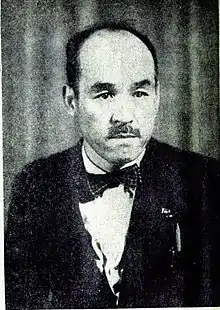Yasujirō Shimazu
Yasujirō Shimazu (島津 保次郎, Shimazu Yasujirō, 3 June 1897 – 18 September 1945) was a Japanese film director and screenwriter, and a pioneer of the shōshimin-eiga (common people drama) genre at the Shōchiku studios in pre-World War II Japan.[1]
Yasujirō Shimazu | |
|---|---|
 Yasujirō Shimazu in 1939 | |
| Born | June 3, 1897 Tokyo, Japan |
| Died | September 18, 1945 (aged 48) Tokyo, Japan |
| Nationality | Japanese |
| Occupation(s) | Film director, screenwriter |
| Years active | 1920–1944 |
Biography
Shimazu was born in Tokyo,[lower-alpha 1] the second son of merchant Otojirō Shimazu. His father owned a long-established seaweed business named Kōshū-ya directly in front of the main Mitsukoshi department store in Nihonbashi.[4]
Shimazu entered Shōchiku in 1920 after answering an advertisement and began training under Kaoru Osanai.[3] He gave his debut as director in 1921 at Shōchiku's recently established Kamata studio,[3] directing both comedy and melodrama films, often depicting the everyday life of the lower middle classes.[1] Our Neighbor, Miss Yae (1934) and A Brother and His Younger Sister (1939) are regarded as his most exemplary and best films.[1][5] By the end of the 1930s, he moved to Tōhō studios, where he made some films in cooperation with the Manchuria Film Association.[6] He died of cancer just after the war ended.[2] Many famous directors, such as Heinosuke Gosho, Shirō Toyoda, Kōzaburō Yoshimura, and Keisuke Kinoshita, started their careers as his assistant.[1]
Selected filmography
- 1930: The Belle (麗人, Reijin)
- 1931: Lifeline ABC (生活線ABC, Seikatsusen ABC)
- 1932: First Steps Ashore (上陸第一歩, Jōriku dai ippo)
- 1934: Our Neighbor, Miss Yae (隣の八重ちゃん, Tonari no Yae-chan)
- 1935: Okoto and Sasuke (春琴抄 お琴と佐助, Shunkinsho: Okoto to Sasuke)
- 1936: Family Meeting (家族会議, Kazoku kaigi)
- 1937: Three Crows' Engagement (婚約三羽烏, Kon'yaku sanbagarasu)
- 1937: The Lights of Asakusa (浅草の灯, Asakusa no hi)
- 1939: A Brother and His Younger Sister (兄とその妹, Ani to soto imōto)
- 1940: Totsugu hi made (嫁ぐ日まで)
Notes
- Depending on the source, either in Kanda[2] or in Nihonbashi[3] district.
References
- Jacoby, Alexander (2008). Critical Handbook of Japanese Film Directors: From the Silent Era to the Present Day. Berkeley: Stone Bridge Press. pp. 264–268. ISBN 978-1-933330-53-2.
- "島津 保次郎 (Shimazu Yasujiro)". Kinenote (in Japanese). Retrieved 23 February 2021.
- "島津 保次郎 (Shimazu Yasujirō)". Kotobank (in Japanese). Retrieved 23 February 2021.
- Otake, Toru (1979). 個人別領域別談話集錄による映画史体系. Nihon University, Faculty of Art, Department of Cinema (日本大学芸術学部映画学科). p. 6.
- Anderson, Joseph L.; Richie, Donald (1959). The Japanese Film – Art & Industry. Rutland, Vermont and Tokyo: Charles E. Tuttle Company.
- Yamane, Sadao (1997). "Shimazu Yasujirō". Nihon eiga jinmei jiten: Kantoku hen (in Japanese). Kinema Junpō. pp. 404–406. ISBN 4-87376-208-1.
Bibliography
- Wada-Marciano, Mitsuyo (2008). Nippon Modern: Japanese Cinema of the 1920s and 1930s. University of Hawaii Press. ISBN 978-0-8248-3240-7.
External links
- Yasujirō Shimazu at IMDb
- Yasujirō Shimazu at the Japanese Movie Database (in Japanese)